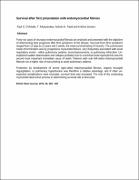| dc.description.abstract | Forty-six cases of necropsy endomyocardial fibrosis are analysed and presented with the objective of determining their prognosis after first symptoms of the disease. Survival from first symptoms ranged from 12 days to 12 years and 2 weeks, the mean survival being 24 months. The commonest mode of termination was by progressive myocardial failure, very frequently associated with acute respiratory events - either pulmonary oedema, bronchopneumonia, or pulmonary infarction. Un-explained sudden deterioration and collapse probably due to a terminal acute dysrhythmia was the second most important immediate cause of death. Patients with sole left-sided endomyocardial fibrosis run a higher risk of succumbing to acute pulmonary oedema.
Protection by development of severe right-sided endomyocardial fibrosis, organic tricuspid regurgitation, or pulmonary hypertension was therefore a relative advantage, and if other un-expected complications were excluded, survival time was increased. The role of the continuing myocardial destructive process in determining survival rate is discussed. | en_US |


